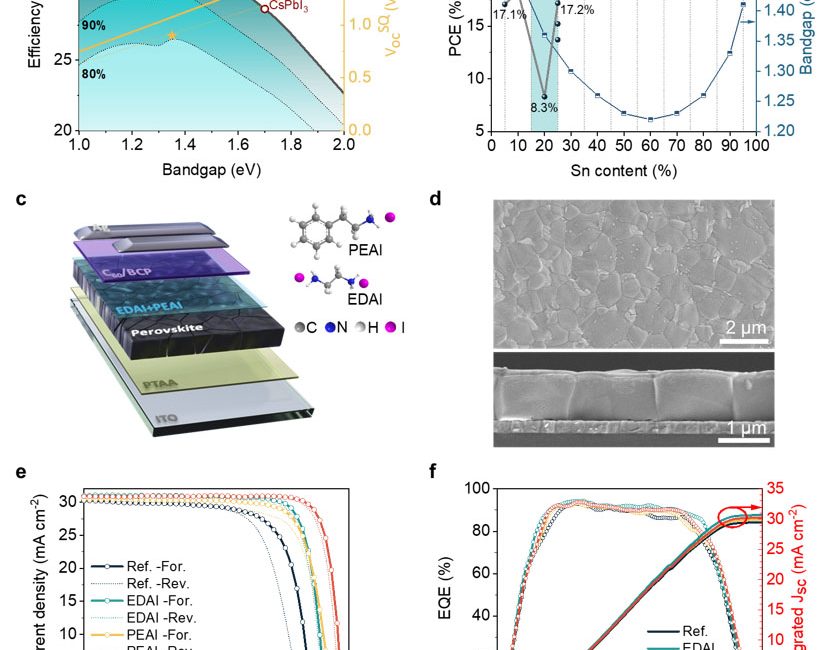| Mar 05, 2022 |
|
(Nanowerk News) In a study published in Advanced Materials (“Selective Targeting Anchor Strategy Afford Efficient and Stable Ideal Bandgap Perovskite Solar Cells”), researchers at the Hefei Institutes of Physical Science (HFIPS) of the Chinese Academy of Sciences reported a novel solution to to tackle bimetallic traps in high-efficiency perovskite solar cells (PSCs) by applying an anchoring strategy.
|
|
In the reported ideal bandgap PSCs, a record power conversion efficiency (PCE) of 22.51% was achieved.
|
 |
| a. S-Q limit efficiencies and open-circuit voltage of different compositions; b. Summary of recent works of LTPSCs and the bandgap variation versus Sn content ratio (blue line); c. Diagram of device structure, inserted graph is chemical structure of anchor molecules; d. Surface-view and cross-sectional SEM images after selective targeting anchor treatment; e. Forward and reverse scan for J-V curves of the reference, ethylenediamine diiodide, phenethylammonium iodide and selective targeting anchor device; f. EQE plots and derived integrated JSC of the reference, ethylenediamine diiodide, phenethylammonium iodide and selective targeting anchor device. (Image: YE Jiajiu)
|
|
Bandgap of plumbum (Pb/lead)-based perovskite materials normally ranges from 1.5 eV to 1.7 eV. However, according to the Shockley-Queisser (S-Q) model, calculated and proposed by William Shockley and Hans Queisser in 1961, the power conversion efficiency peaks at a band gap of 1.33 eV.
|
|
Considering this, the researchers attempted to lower the bandgap of the theoretically highest PCE to 1.33 eV by partially or entirely replacing Pb with stannum (Sn/tin). In fact, adding Sn directly up to 20% without any doping, the bandgap did drop to around 1.33 eV. But 20% Sn brought a new problem of a massive open-circuit voltage loss.
|
|
“The voltage loss is mainly due to bimetallic traps,” said PAN Xu who led the study and a researcher specialized in perovskite solar cells for years at HFIPS.
|
|
Bimetallic traps are actually caused by the most intense turbulence of energy and crystal structure, and PAN’s team decided to adopt a targeting anchor strategy to stop this turbulence.
|
|
They firstly synthesized a bromine-free lead-tin perovskite material with a bandgap of 1.33 eV. They then established an anchoring strategy that phenethylammonium iodide and ethylenediamine diiodide were introduced as “co-modifier”, selectively anchoring with Pb- and Sn-related active sites, and “passivating bimetallic traps,” according to the team.
|
|
Furthermore, energetic depth specificity of Pb- and Sn-related traps has been clearly demonstrated in the selective mechanism of molecular orientation anchor passivation.
|
|
After they adopted this strategy, they were surprised to find that the open-circuit voltage increased from 0.79 V to 0.90 V. The conversion efficiency also reached 22.51%.
|
|
“I think our work may reveal metal dual source defects in lead-tin perovskite solar cells,” said PAN, who is expecting their work could provide useful passivation mechanisms in response to bimetallic traps.
|


